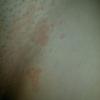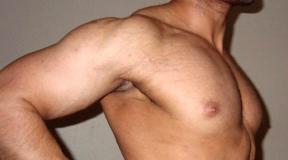What does colostrum look like? Reasons for the release of colostrum from the breast in the absence of pregnancy. Breast hygiene during colostrum release
During pregnancy, a woman’s body is rebuilt in preparation for bearing and then feeding a child. The concentration of hormones and the condition of the mammary glands change during this period, and one of the manifestations of this process is the production of colostrum. What kind of liquid is this, why is it needed and when is it released, what is its composition?
Composition and purpose of colostrum
Colostrum is a yellowish liquid, viscous in consistency, and sweetish in taste. It appears during pregnancy (on average in the 2nd trimester), and approximately 90 hours after the birth of the baby, it is replaced by milk.
Colostrum contains the following substances:
- proteins (albumin, globulins);
- carbohydrates (lactose);
- fats;
- bifidobacteria, lactobacilli;
- vitamins A, B, C, E, PP;
- mineral salts;
- water;
- enzymes;
- hormones.
 Colostrum, transitional milk and mature milk
Colostrum, transitional milk and mature milk Colostrum is a valuable product for the baby, and it should be his first food. The digestion process begins with it, because the product supplies the child’s body with everything it needs until milk appears. Colostrum performs a number of important functions:
- supplying the baby’s body with immune cells, developing resistance to harmful microorganisms coming from outside;
- creation of beneficial intestinal microflora, normalization of digestion;
- removal of excess bilirubin from the child’s body, which prevents the development of jaundice;
- saturating the body with antioxidants that stimulate the functioning of the respiratory system;
- ensuring the growth and development of the baby thanks to the mineral and vitamin complex included in colostrum.

When does colostrum begin to be produced and appear?
Many women ask the question: “When does colostrum appear?” The hormonal background of the expectant mother begins to change already in the first day after conception. The mammary glands are also activated, and in some women the product useful for the baby comes already in the early stages, after a delay in menstruation. However, expectant mothers usually notice a slight discharge from the nipples in the 2nd trimester.
During the third trimester (around 32 weeks), the fluid becomes less thick and more clear. Its amount usually does not change until childbirth. However, there are a number of factors that stimulate the release of colostrum:
- massage of nipples, mammary glands;
- hot bath or shower;
- prolonged sexual contact;
- strong emotional experiences;
- warm drink.

What should colostrum be like (color, taste, consistency, amount of discharge)
Breast discharge during pregnancy usually has a yellowish tint (pale to bright yellow). After childbirth, colostrum is almost orange, because during this period it contains a large amount of carotene.
When the breast “product” just begins to stand out, it looks translucent and non-sticky (see photo). From 30 to 35 weeks of pregnancy and especially after childbirth, colostrum is saturated with useful substances, contains less water, so its consistency becomes thicker. It tastes slightly sweet because it contains carbohydrates. The amount varies among women: for one, only a couple of drops come out when pressed, for another – up to 5 ml.
Do I need to express colostrum?
It is not recommended to express nipple discharge during pregnancy (see also: what nipples look like during pregnancy: photo). Why can't you squeeze out colostrum? The fact is that when the mammary glands are stimulated or pressed on them, the hormone oxytocin is released, which causes uterine contractions. Pumping can lead to premature birth or miscarriage.
All breast stimulation should be avoided to maintain pregnancy. If colostrum is actively secreted (from 32 weeks), it is enough to use breast pads, which should be changed regularly.
Discharge from the chest as a sign of pathology
If the colostrum is sticky, yellow, and odorless, this is normal. However, it happens that one of the characteristics of the breast fluid changes and alarms the expectant mother. If colostrum is produced in only one breast or symptoms appear in the form of an unpleasant odor, blood spots, or pain in the mammary glands, then it’s time to see a doctor.
Painful sensations
Blood admixture
When breast secretions are released from the breast, the ducts dilate. With active fluid secretion in the middle and second half of pregnancy, the ducts fill, capillaries often break, and the discharge becomes reddish in color. At the same time, the expectant mother feels pressure inside the mammary gland, which signals active preparation for lactation. In this case, such signs are a variant of the norm.

However, there are cases that require medical intervention. You need to pay attention to how much blood is mixed into the colostrum. If the discharge contains a lot of blood, and the general condition of the pregnant woman is poor, and pain is felt in the lower abdomen or chest, you should see a gynecologist as soon as possible. The doctor will probably direct the pregnant woman to have her colostrum tested.
Unpleasant smell
If colostrum during pregnancy has a foul odor, this is another alarm bell. This symptom indicates the presence of a bacterial infection. In this case, you will also need to donate fluid from the breast for analysis. If the diagnosis is confirmed, treatment with antibiotics approved during pregnancy will be required. Medicines can protect the fetus from infection.
If the infection occurs in the last month of pregnancy, then in this case it is also important to undergo a course of antibiotic therapy both to protect the baby and to provide him with clean nutrition from the mother's breast. It is necessary to be cured before the baby is born.
What to do if colostrum appears: breast care rules

When colostrum begins to appear, the breasts require a little more attention. The rules for caring for this part of the body are very simple:
- Wearing a soft bra that does not compress the mammary glands. The ideal option would be a special model for pregnant or lactating women. It is necessary that the bodice be of the appropriate size and made of breathable material.
- Rinse your breasts twice a day with warm water without detergent. This action must be performed to prevent the proliferation of microbes, the appearance of cracks, and the development of the inflammatory process.
- After washing, you should dry your breasts with a soft towel, blotting the skin and avoiding sudden movements.
- If there is a lot of colostrum and it flows (this often happens from 35 weeks), a special breast pad or a cotton pad or a clean cotton handkerchief should be placed between the bra cup and the nipple.
- Breast massage and other touching should be kept to a minimum so as not to provoke excessive colostrum secretion and stimulation of the uterus. The same applies to pumping.
- Use a cream with a moisturizing effect (there are special products for pregnant women). This will prevent cracks and stretch marks from appearing. How many times should I apply the cream to my breasts? Once a day will be enough.
- Follow a diet: eat more fresh fruits, vegetables, proteins of plant and animal origin (meat, fish, legumes, etc.). Reduce the amount of potatoes, white rice, and flour products you consume. 4 weeks before giving birth, eat more healthy fats. During pregnancy, you should say a firm “no” to alcohol and tobacco. The same rules apply to women who have given birth and whose breasts produce mature milk.
So, colostrum can begin to appear at any stage of pregnancy, even immediately after a missed period. If the expectant mother notices that alarming symptoms have arisen, she should consult a doctor. In any case, you need to be attentive to your health and take care of your breasts when producing colostrum.
In anticipation of the birth of a baby, the happiness of motherhood, a woman already imagines in advance how she will breastfeed her baby. This is joyful anticipation. But at the same time fear appears: will there be milk, will there be enough for the baby? These issues are especially concerning for women expecting their first child.
The woman is anxiously waiting for the first proof that she will still have milk, the baby will not go hungry and will receive the most complete nutrition from the mother. The first evidence is the appearance of colostrum.
This article will talk about colostrum. You will find out when to expect it to appear, how many days it arrives before mature milk appears after birth, and why the baby needs it so much.
What is colostrum and what is its importance for the baby?
Colostrum is the secretion of the mammary gland that precedes mature milk. It is pale yellow in color and has a sticky consistency. The first colostrum appears earlier, before childbirth, but begins to be actively released after childbirth. And 1 to 4 days after birth it is replaced by mature milk.
This valuable product is produced in small quantities and has a higher calorie content than regular milk. Therefore, a newborn baby does not need so much.


And mothers often worry that they secrete literally drops of colostrum after childbirth, and that they will not be able to feed the baby with this amount.
Colostrum is rich in immunoglobulins (these are immune proteins that transfer immunity to the child from the mother), proteins, and fats.
The mother's immunoglobulins will protect the baby from infections even before the age of six months, while his immunity is developing. Therefore, early latching of the baby (immediately after birth) and feeding with colostrum is so important.
It is also rich in vitamins and antioxidants. And this is additional support for the weakened immunity of a newborn, who in the first days and weeks of life constantly encounters still unfamiliar microorganisms.
Colostrum also helps bind excess bilirubin in the baby’s intestines. That is why frequent feeding and feeding with colostrum is considered a kind of prevention of physiological jaundice in a newborn.
Colostrum contains laxatives that help cleanse the baby's intestines of original feces (meconium).
Colostrum contains many enzymes that help digest breast milk. The substances it contains contribute to the maturation of the baby's enzymatic system.
It is also rich in lacto- and bifidobacteria, which should first colonize the still sterile intestines of a newborn baby.
Also, colostrum, due to the content of oligosaccharides, has a prebiotic effect. In other words, it promotes the colonization and growth of beneficial microflora in the baby’s intestines.
Also, from a physiological point of view, such a transitional stage of feeding colostrum during the period of adaptation of the child to a change in type of nutrition is very necessary. After all, in the body of a newborn, all systems are launched gradually.
For example, due to their immaturity, the kidneys of a newly born baby find it difficult to cope with a large water load. And colostrum does not contain as much water as mature milk or formula.
Therefore, colostrum is an ideal product for feeding a newly born baby. And there is no need to rush to feed him with formula, hoping that it is better than this small amount of colostrum.
When does colostrum begin to be produced?
With the onset of pregnancy, various transformations occur almost immediately in the mammary gland. It increases in volume, becomes more sensitive, sometimes even painful.
A little later, pigmentation halos appear around the nipple. But few people know that almost immediately the gland begins to gradually produce a secretion - colostrum.


Colostrum can be released from the breast at any stage of pregnancy. Long-term observations have shown that its release at various periods is the absolute norm. And if it is detected very early or, conversely, does not appear at a later stage, there is no need to panic or worry. Everything is considered an individual norm.
It happens that some mothers find out about the onset of pregnancy precisely by the droplets of this secretion released on the bra. But these are rather isolated cases.
Still, the release of colostrum in significant quantities in the early stages of pregnancy is an undesirable phenomenon. This can be contributed to by various factors, which, as a rule, should be excluded during pregnancy.
These include:
- taking a hot shower or bath;
- hot drinks such as coffee, cocoa or tea;
- stressful situations;
- long stay in a hot, stuffy room;
- stimulation or massage of the mammary glands.
In the generally accepted average, colostrum begins to be noticeably released from the breast only after 15-16 weeks. But this is not necessary; this does not happen to all women. But in the third trimester of pregnancy (from 32-33 weeks), almost all pregnant women notice its release from the mammary gland.
Moreover, this phenomenon cannot be attributed to obvious precursors of childbirth, since colostrum can be released from the breast at any stage of pregnancy.
Another thing is that by the time of childbirth there is more of it. The hormonal background, namely an increase in the concentration of the hormone oxytocin before the onset of active labor, promotes the release of colostrum from the breast. And such secretion is no longer unnoticeable.
The question arises: is the future quantity and quality of milk somehow related to the time of appearance and amount of colostrum?
The answer is no, it is not related. Nature has given all women the opportunity to breastfeed their offspring equally. Therefore, whether or not colostrum is released from the breast before birth does not have much significance for further lactation.
That is, it cannot be said that with the early appearance of colostrum during pregnancy, lactation after childbirth will quickly establish and be long-lasting. It also cannot be said that in the absence of colostrum during pregnancy, a woman will have problems with lactation after childbirth.
So do not listen to the frequent idle talk of non-specialists about the direct connection between the period of release and the amount of colostrum during pregnancy and the formation of good lactation after childbirth.
What should a pregnant woman be wary of when releasing colostrum?
It must be understood that the release of colostrum is always accompanied by certain hormonal changes, which have the same stimulating effect on the muscles of the uterus.
Therefore, you need to be attentive to your health. For example, a significant amount of colostrum in the early stages of pregnancy can provoke nagging and spasmodic pain in the lower abdomen or lower back.
At the first sign of such pain, you should immediately consult a doctor. This may indicate increased muscle tone in the uterus, which can lead to miscarriage or premature birth.
Normally, women during pregnancy may feel heaviness and slight tingling in the chest. But in a situation where the release of colostrum is accompanied by severe pain and swelling in the chest, the woman should definitely see a specialist (gynecologist or mammologist - a specialist in the mammary glands).
Normally, the secretion released from the breast should have no odor. But if you notice any impurities in the colostrum (blood or pus) or smell the unpleasant smell of this secretion, then this is no longer normal.


Such situations may indicate an infectious process in the mammary gland. To diagnose and treat such a pathology, you must immediately consult a doctor.
There are rare cases when colostrum appears in non-pregnant women. This is not the norm, but a pathology. Colostrum can only be produced when the concentration of certain hormones (prolactin and oxytocin) increases.
And if the increase in the level of these hormones is not caused by pregnancy, then it is possible that a neoplasm, that is, a tumor, is taking place in the woman’s body. Therefore, you urgently need to undergo a set of examinations from a mammologist, who will help exclude this terrible diagnosis.
How to care for breasts when colostrum is leaking?
First of all, let me remind you that it is prohibited, regardless of the stage of pregnancy, to squeeze or try to express colostrum from the breast.
If colostrum is released before birth, you need to adhere to some breast care rules.
- Wear a comfortable and soft (wireless) bra, such as a nursing bra.
- If a significant amount of colostrum is released from the breast, you can use special disposable breast pads. This will help protect your clothes from wet stains.
- It is necessary to wash the mammary glands with warm water twice or thrice a day, since colostrum is a good breeding ground for various bacteria and fungi.
- During breast hygiene, it is better not to use soap or shower gels, just wash your breasts with warm water.
- You need to wipe your breasts carefully, using a blotting motion with a soft towel (do not rub).
- You should not take a hot shower or be in a hot room (steam room, sauna). This may promote the release of colostrum.
- When colostrum is released, itching or irritation may occur in the nipple area. Therefore, for the prevention or treatment of cracks and irritation that have already appeared, you can use special protective or wound-healing creams with dexpanthenol (Dexpanthenol, Panthenol, Bepanten).
- It is not advisable to massage the mammary glands during pregnancy. After all, this can lead to stimulation of lactation and increased muscle tone of the uterus.


Bottom line: expectant mothers should not worry about whether they will release colostrum during pregnancy, since the process of its formation in the mammary glands is definitely, one hundred percent, started. And sooner or a little later you will see it.
The main thing is to try not to miss the slightest opportunity to feed your baby these valuable products after giving birth. Even if for some reason your stay in the maternity hospital together is not yet possible.
You can always express your colostrum and transfer it to your baby in another ward. It is important that you are interested in this. And may breastfeeding be a joy to you!
During pregnancy, you noticed a thick/viscous/sticky discharge of a yellowish, transparent or creamy consistency from your breasts - is this normal or a pathology? Let us immediately hasten to reassure you - this is the release of colostrum - an absolutely normal and safe phenomenon. If you have not produced colostrum throughout your pregnancy, this is also quite normal.
What is this?
Colostrum — This is a thick, viscous, sticky liquid of a yellowish, transparent or creamy hue, with a specific odor and slightly sweet taste, which is secreted by a woman’s mammary glands during the period of bearing and feeding a child. The production of colostrum in the mammary glands is a normal physiological process. It is usually released in women in the first two to three days after the birth of a child. But colostrum can also be released at different stages of pregnancy by the expectant mother.. Colostrum is also called “immature milk” because it precedes the appearance of real breast milk. Colostrum also differs from milk in its composition: it contains less fat and sugar, but more protein.
This is what colostrum looks like
How is it useful?
Colostrum is very beneficial for the baby in the first days of his birth. It is saturated with antibodies that protect the baby from infections and contribute to its rapid adaptation to the outside world. It contains all the nutrients a child’s body needs for normal functioning.
Chemical composition of colostrum: albumins and globulins - proteins (up to 6-7%); water (84-88%); bifidumbacteria; lactobacilli; vitamins of group A, B, C, E, PP; milk sugar (lactose) – carbohydrates (up to 5-5.5%); fats (4-5%); mineral salts; food enzymes (amylase, lipase and protease); hormones.
Colostrum is higher in calories than milk itself and contains less water. Despite this, it is easily absorbed by the newly born organism and prepares the baby’s digestive system for the absorption of heavier food - real breast milk (). The first food of a newborn - colostrum - has a laxative effect, which ensures easy release of feces from the intestines. Colostrum promotes the excretion of bilirubin, thereby reducing the risk of occurrence.
Colostrum during pregnancy
While the baby is growing and developing in the womb, the body of the expectant mother is preparing to feed her child throughout the entire nine months. Early in pregnancy, the mammary glands begin to swell and women may experience mild pain. Changes also occur at the hormonal level, which leads to the production of colostrum.
Note to moms!
Hello girls) I didn’t think that the problem of stretch marks would affect me too, and I’ll also write about it))) But there’s nowhere to go, so I’m writing here: How did I get rid of stretch marks after childbirth? I will be very glad if my method helps you too...
When does it appear?
As for the timing of the appearance of colostrum, there is no clear answer. The production of milk fluid begins from the moment of conception, although a woman may not feel this in the first trimester. But unripe milk is produced more actively by the body already in the second trimester. Externally, this may appear in the form of yellowish sticky drops that remain on clothing. Two months before birth, the color of colostrum becomes more transparent, but the amount usually does not increase. And even if the expectant mother does not detect droplets of unripe milk until the very moment of birth, then there is nothing dangerous in this either. One way or another, it is produced in the body: this process is laid down by Mother Nature.
In some cases, a woman experiences the appearance of colostrum even in the early stages of pregnancy. Doctors do not see any threat to either mother or baby in the early release of immature milk. You should not be afraid of slight itching and tingling around the nipples that may accompany the release of colostrum.
What stimulates the production of colostrum?
The release of colostrum during pregnancy is facilitated by factors such as:
- a surge of emotions (positive and negative);
- prolonged sexual intercourse;
- taking a hot shower;
- breast massage;
- at high air temperatures, especially in summer;
- drinking hot tea or other drinks.
Deviations from norms
So, the release of colostrum at any stage of pregnancy is a completely normal process that occurs in the body of the expectant mother. However, a woman, having noticed a similar phenomenon in herself, should focus on such points as:
- Colostrum color. Normally, it should be a rich creamy shade, then, closer to childbirth, it becomes more transparent. If small particles of blood are mixed into the liquid, you should be wary, but do not panic. The presence of blood can be either normal or a sign of a disease. Here you will definitely need consultation with specialists (mammologist, surgeon, oncologist) and a detailed examination of the body (ultrasound of the mammary glands, MRI, mammography, etc.).
- Amount of colostrum. Usually a little fluid is released, although this process, like all pregnancy, manifests itself individually. If a woman feels that there is too much fluid being released, then a consultation with a mammologist will not be superfluous. It is worth knowing that increased breast congestion during pregnancy leads to an increase in the level of the hormone oxytocin. And this is fraught with an increase in the tone of the uterus, which is dangerous and leads to the threat of miscarriage. But perhaps the intense production of colostrum is due to the factors described above. Stress, intense massage, hot showers stimulate the process of milk fluid secretion.
- Foul odor and impurities of pus in colostrum. This symptom may indicate the presence of a bacterial infection in the ducts of the mammary glands. In this case, the expectant mother may experience an increase in body temperature and a deterioration in her overall health. Contact a doctor and treatment should be immediate to reduce the risk of infection of the fetus.
- Chest discomfort. A slight tingling and slight itching that accompanies the release of colostrum is normal. But if a woman feels severe pain or notices depressions and bumps on the mammary glands, then she needs to immediately tell a doctor about it. The presence of accompanying pain in the lumbar and lower abdomen is also a bad sign. Such symptoms can lead to spontaneous miscarriage or premature birth. You should not wait for such a terrible situation; it is better to go to a medical facility in time.
Colostrum in non-pregnant women
Colostrum can be produced not only during pregnancy and lactation, but also after the completion of the baby’s feeding period for 1-2 years. The sudden appearance of colostrum, not associated with pregnancy and recent feeding of the child, may mean that the content of hormones - oxytocin and prolactin - has increased in the woman’s body. And here you shouldn’t wait and think for a long time: you should immediately run to a mammologist. What can the unexpected appearance of colostrum in the mammary glands signal?
- hormonal imbalance in the body;
- (in this case, pus is released);
- fibroadenoma and other tumors.
Important: In cases of taking contraceptives, some women experience periodic release of colostrum before the start of the menstrual cycle. However, it is worth taking a blood test to make sure there are no diseases.
Hygiene rules during the period of colostrum release
The presence of colostrum forces a woman to take more careful care of her breasts. After all, this sweetish liquid contributes to the formation of a favorable environment for the appearance and active reproduction of bacteria. That's why The expectant mother needs to pay special attention to body hygiene and adhere to simple rules:

Important: Failure to follow these rules can lead to inflammation of the ducts in the mammary glands.
Remember that virgin milk is very valuable for your baby. Put your newborn to the breast as often as possible so that he receives the necessary supply of nutrients and is maximally protected from external influences. Feeding is especially important in the first hour of a baby’s birth (). The ideal duration of the feeding period in the first days is 20 minutes. Frequent breastfeeding will not only help the baby, but will stimulate the lactation function of the mother's mammary glands. Colostrum is the health of your baby.
The appearance of colostrum. From an obstetrician-gynecologist with 30 years of experience
After the baby is born, milk does not appear immediately. For the first 2-3 days, a very small amount of clear yellowish liquid is released instead. The young mother begins to worry that the baby will not take an empty breast and will remain hungry. But that's not true. Colostrum is superior in nutritional value to milk, and the amount that is released is sufficient for the child in the first days. It can appear already during pregnancy. Most often this happens in the second half as a result of hormonal processes associated with preparing the body for lactation and feeding the child.
Advice: If any discharge from the nipples appears, it is better to immediately contact a gynecologist, since discharge is often a sign of a disease of the mammary glands.
Most often, colostrum appears after the 19th week or just before birth. The appearance of colostrum during pregnancy at any stage, as well as the absence until birth, is the norm. The following factors influence its formation and intensity of discharge from the breast:
- emotional state of a woman;
- bathing in a hot shower;
- drinking hot tea, milk;
- having sex;
- nipple stimulation.
The formation of colostrum and milk depends on the level of prolactin in the body, a hormone produced by the pituitary gland. There is an opinion: the more colostrum is released, the more milk there will be. However, there is no direct connection between the amount of colostrum and the intensity of subsequent lactation.

Colostrum as a precursor to miscarriage
Sometimes women think that the appearance of colostrum portends labor and are afraid of its premature onset. However, during pregnancy, the formation of colostrum does not affect its course and is determined only by the individual physiological characteristics of the body.
But the appearance of colostrum together with pain in the lower abdomen can be a sign of a possible termination of pregnancy if there are prerequisites for this (congenital pathologies of the development of the uterus or its diseases, for example). In this case, the woman is placed in a hospital where treatment is carried out to prevent miscarriage or premature birth.
Composition and properties of colostrum
Colostrum initially appears as a thick, slightly sweet mass of yellow-gray color. As labor approaches, it becomes thinner. It contains valuable proteins (their content is 4-5 times higher than in mature milk), fats, milk sugar (lactose), mineral salts, enzymes, hormones, bacteria beneficial to the intestines, vitamins (A, B, C, E and PP), as well as water.
Video: Beneficial properties of colostrum
The importance of colostrum for a newborn
In the body of a newborn baby, colostrum performs the following functions:
- Promotes the development of the immune system, saturating the baby’s body with valuable proteins. During the first 6 months of life, the child's immune system is immature and does not provide the necessary protection to his body from infection.
- It is a source of beneficial bifidobacteria and lactobacilli, which create normal intestinal microflora and prevent the proliferation of pathogenic microbes. In the first days, the child’s intestines are filled with original feces (meconium), which got there during intrauterine development. Colostrum promotes their excretion and prepares the body for the absorption of milk.
- Removes excess bilirubin formed due to liver immaturity. Accumulating in the blood, bilirubin turns the skin and whites of the eyes yellow (physiological jaundice). Excess of this substance is dangerous for the child’s brain and nervous system.
- By supplying hormones, colostrum promotes the maturation of the intestinal mucosa.
Breast care when colostrum appears
Some women mistakenly believe that colostrum production needs to be stimulated in order to produce more milk later. For this purpose, they begin to express colostrum. This cannot be done for the following reasons:
- This will not help milk production;
- when expressing, the skin of the nipple or the area around it may be damaged, infections may get into the cracks, and an inflammatory process may occur;
- stimulation of the nipples leads to an increase in the blood of the hormone oxytocin, which increases contractions of the muscles of the uterus, provoking miscarriage or premature birth.
If you feel a slight itching when you release colostrum, this may be the result of breast enlargement, stretching of the skin, and the movement of colostrum through the milk ducts. To prevent stretch marks from remaining on the skin, it is necessary to use special creams.
When colostrum appears, a pregnant woman should wear a bra that supports her breasts well and does not tighten them. If colostrum gets on your laundry, humidity and heat create all the conditions for bacteria to multiply. To avoid infection in the mammary glands, you need to wash your breasts several times a day with warm water without soap, and also use replaceable breast pads or cotton pads.
Video: How to care for your breasts during pregnancy
When colostrum leakage may be a sign of pathology
Sometimes during pregnancy you may notice traces of blood in the colostrum. Their presence is caused by damage to small capillaries due to the proliferation of a network of milk ducts penetrated by blood vessels. If a woman does not have other unusual signs, then this condition at 6-7 months is not a pathology and goes away on its own.
The doctor leading the pregnancy must be aware of all changes in the woman’s condition, including changes in the nature of discharge from the nipples. The following signs indicate pathology:
- yellow or white discharge from the nipples is accompanied by constant aching pain localized in any part of the mammary gland;
- the mammary glands enlarge unevenly;
- seals can be felt in them, there are depressions, and unusual changes appear in certain areas of the skin.
To diagnose the pathology, a blood test for hormones and antibodies to viruses, mammography, ultrasound, ductography of the mammary gland ducts, MRI, and breast examination may be required.
Discharge from the nipples of a pregnant woman as a sign of disease
Threat of miscarriage. In addition to the release of colostrum, a woman has such signs as blood discharge from the vagina, swelling of the mammary glands, pain in the chest, lower back, and lower abdomen. To maintain the pregnancy, she needs to go to the hospital.
Ectasia- expansion of the milk ducts, accompanied by their inflammation. May occur in one or more ducts. In this case, thick sticky discharge appears, which is brown or green in color. Compresses and antibiotics are used for treatment.
Intraductal papilloma- a benign tumor of the milk ducts, the formation of which is caused by the human papillomavirus. Thick red discharge in a pregnant woman appears from one breast affected by papillomavirus. The affected area is removed surgically.
Mastitis- inflammation of breast tissue. It occurs extremely rarely during pregnancy (for example, with chest injuries). If the inflammation is accompanied by suppuration, the discharge is green and has an unpleasant odor. The woman's temperature rises, the affected breast becomes red and swollen. There is a risk of fetal infection and miscarriage. Treatment is carried out by opening the abscess and cleaning. Antibiotics are then used.
Nipple cancer. The discharge is bloody, the nipple is retracted. Pregnancy aggravates the course of the disease, so it is usually terminated.
Fibrocystic mastopathy- benign growth of breast tissue. With this disease, nipple discharge during pregnancy resembles colostrum. There is a nagging pain in the mammary gland. The reason is hormonal changes in the body. Treatment is usually not carried out in pregnant women. Often after childbirth, when hormonal levels are restored, the disease goes away on its own.
If the pregnant woman is healthy, then the amount of colostrum released does not matter. 3-4 days after birth and the baby is put to the breast, colostrum turns into milk.
Colostrum appears at different times during pregnancy in different women. For some - earlier, for others - immediately before childbirth. And the expectant mother does not always understand the mechanisms of its formation and purpose, because there is still so much time before the baby is born.
In this material we will talk about what colostrum is, when it is normally released and whether it needs to be squeezed out.

What is it
Colostrum is a thick secretion from the mammary glands. It is produced in all mammals: cats, dogs, cows and goats. People are no exception. A few days after birth, thick and viscous colostrum is replaced first by transitional milk, and then by full-fledged breast milk, which in medicine is usually called mature.
In pregnant women, colostrum is released under the influence of changed hormonal levels, because the mammary glands of the expectant mother begin to adapt to the upcoming breastfeeding in advance. Colostrum is a thick, sticky, salty liquid.
In the early stages of pregnancy, it can be transparent, a little later its color changes to various shades of yellow, closer to childbirth, colostrum begins to lighten again, so that after birth it becomes white and opaque, turning into transitional milk. This usually takes from 2 to 5 days.


Colostrum is completely different from milk: they have nothing in common either in composition, consistency, or properties. In its chemical structure, this liquid is more reminiscent of the composition of blood. Despite the fact that in the later stages and immediately after birth it looks almost like breast milk, it differs in color and quantity.
Nature has assigned the most important function to colostrum - it should provide the child with a smooth transition from nutrition through the placenta to nutrition in the usual traditional way. Colostrum will give the baby the necessary protective antibodies and antitoxins so that the tiny organism can survive as easily as possible the enormous stress that will be associated with its birth into this world and adaptation to completely different conditions of existence.

Composition and properties
In terms of energy value, colostrum is significantly superior to breast milk and any artificial milk formula. It is thick and viscous, it contains little water (excessive load on the weak kidneys of a newborn will not benefit him).
But the density of nutrients in it is several tens of times higher than in full-fledged breast milk, which the baby will be fed about a week after his birth.
Colostrum not only effectively removes the feeling of hunger and saturates the baby, but also promotes soft and quick bowel movements. It contains natural laxatives that help the baby, on the very first day, empty the intestines of meconium - the original dark green feces that accumulated in it during the prenatal period of development.

Colostrum mitigates the consequences of the destruction of red blood cells: it reduces the level of bilirubin, as a result of which the baby may not have physiological jaundice, or it will occur in its mildest and simplest form.
If we consider colostrum from the point of view of its chemical composition, then, in fact, it is a mixture of easily digestible proteins - albumins and globulins. Unlike regular milk, colostrum contains less casein, lactose and fats, which are quickly absorbed. It contains a large amount of natural antioxidants - vitamins A and E, as well as zinc and selenium.
In addition to the fact that these substances are involved in preventing “oxygen stress” in a newborn, they also help the difficult process of establishing the independent functioning of children’s immunity.

In terms of chemical composition and properties, colostrum has no analogues in nature - it is a unique, valuable and important liquid that increases the newborn’s chances of survival and normal subsequent development.
Protective factors
Everyone knows that with breast milk, a mother passes on antibodies to her child, which in the first months of his life form passive (or innate) immunity. But not everyone knows that the content of immune factors is higher in colostrum than in milk. In particular, this applies to substances such as immunoglobulin A, lactoferrin. Colostrum is rich in living macrophages-leukocytes, neutrophils and lymphocytes.
All these “tenants” of the mammary gland secretion do not participate in the baby’s digestion and are not digested by his body. Once they enter the stomach, they remain in the gastrointestinal tract, where they come into “combat readiness”, protecting the baby from the invasion of pathogenic bacteria and aggressive viruses that penetrate through the mouth.

T-lymphocytes in colostrum exceed in number the number of similar cells in the blood. Leukocytes from colostrum can help the child develop protection against viruses. Some polysaccharides, which are part of the secretion of the mammary glands, act as an anti-glue - they prevent harmful microorganisms from attaching to the intestinal walls and mucous membranes of other organs.

Laboratory research has demonstrated interesting facts: it turns out that female colostrum is a unique natural antibiotic and antiviral agent “in one bottle.” It actively resists E. coli, salmonella, cholera pathogens, dysentery bacillus, and can also destroy the structure of many viruses - rotavirus, Coxsackie virus, polio pathogen, herpes virus.
That is why it is customary to put a baby to the breast in the delivery room, so that from the first minutes of life in a world filled with bacteria and viruses, he is ready to fight back.
From the same point of view, it is important to put the baby to the breast in the first days after birth, even if there is no milk yet. Even a few drops of colostrum are quite enough to fill the baby, because this liquid will satisfy all his energy needs in full, and besides, these days are very important for future health.

The immunity of children who were given colostrum is always stronger and stronger than the immunity of children who were given donor milk or artificially adapted milk formulas from the first days. This means that such children get sick less often and more easily, and grow stronger and more resilient.
Reasons for appearance
Under the influence of progesterone, from the very first hours after the baby is conceived, large-scale changes begin in the body of the expectant mother, who has no idea what is really happening. They also concern the mammary glands.
Of course, other hormones also help progesterone. That is why sometimes a woman begins to guess that conception has occurred even before her period is missed - by the characteristic swelling of the breasts and pain in the nipple area.
The ducts located inside the mammary gland gradually expand, the glandular tissue grows, which is why the breast increases in size. Colostrum begins to be produced by the mammary gland when the level of the hormone prolactin allows it.

Prolactin increases gradually, which is why some women develop colostrum already in the first trimester, while others only a couple of months before giving birth. The production of prolactin is controlled by the pituitary gland; the process itself is the first stage of lactogenesis.
Very often, pregnant women may hear the opinion that a small amount of colostrum during pregnancy may be a sign of future problems with the amount of breast milk. This statement is a mistake or profanation.
Neither the quantity, nor the quality, nor the color of colostrum, nor its absence or presence during pregnancy, affects how much milk will be produced after childbirth. After the baby is born, the second stage of lactogenesis will begin, during which colostrum will begin to change its chemical composition under the influence of oxytocin.

Some women do not produce colostrum during pregnancy; it begins to be released only after childbirth, and this does not affect lactation in any way - such mothers breastfeed their babies well.
Dates of appearance
There are no uniform standards regarding at what stage of pregnancy, at what week colostrum should begin to be released. In primiparous women, whose prolactin levels are initially low and whose nipples are stronger, colostrum may begin to be released shortly before or even after childbirth.
In this case, the breasts will hurt, swell, and at an earlier stage, perhaps, when pressing on the nipples, a small, barely noticeable amount of thick liquid will be released.
Most often, primiparous women indicate that the first signs of colostrum appeared in them at about 10-12 weeks of pregnancy. Even more often the terms are indicated - 16-18 weeks. In the majority, it did not flow out and was detected only by mechanical pressure with fingers on the nipple on both sides.

If a woman already has experience breastfeeding and has given birth, then in subsequent pregnancies colostrum will arrive earlier. The fact is that the level of prolactin in the body of a woman who has already given birth is always higher than that of a nulliparous woman. In addition, the ducts of the mammary gland are already dilated after the first child, and therefore there will be more colostrum; it can leak, causing hygienic inconvenience to the woman.
Is it possible to squeeze out?
The answer to this question is clear - squeezing out colostrum is strictly prohibited. Mechanical stimulation of the nipples activates the production of oxytocin, a hormone that tones the smooth muscles of the uterus. Increased tone creates a threat of miscarriage in the early stages or premature birth at more noticeable stages of gestation.
Increased uterine tone increases the likelihood of developing fetoplacental insufficiency, and also contributes to the development of oxygen starvation of the fetus.

From this point of view, you should avoid not only squeezing out colostrum, but also accidental mechanical impact on the nipples, for example, during massage, washing the mammary glands, preparing them for breastfeeding, or during sex. Both drinking a hot drink and taking a hot bath can increase oxytocin levels.
Squeezing out colostrum does not make sense after childbirth either - usually the processes of lactogenesis proceed independently. The exception is when a woman has already had transitional milk, and the nipples are too “tight” and the baby cannot “suck” them.
Pumping is also indicated when converting colostrum into milk when it is not possible to feed the baby fully (the baby does not eat much, the nipples have individual anatomical features that make them difficult for the child to grasp, and also if the baby is not brought in for feeding (he is in intensive care or undergoing procedures). )). Expressing in this case will stimulate milk production, and then the child will not need complete, healthy and much-needed nutrition.


If colostrum leaks intensely during pregnancy and stains the pregnant woman’s clothes and underwear, it is best to use a special bra. These are made especially for nursing mothers. They provide space for liners that will absorb excess liquid, preventing unpleasant stains on clothes.
Possible problems
Colostrum, which was present and suddenly disappeared, may be an indirect sign of a frozen (non-developing) pregnancy. Along with the disappearance of colostrum, other symptoms of an “interesting situation” usually disappear - toxicosis, increased appetite. At later stages, fetal movements stop and its heartbeat cannot be heard.
It should be noted that in the event of intrauterine fetal death, colostrum does not disappear immediately, but several days after the tragedy. In the early stages, a woman may not feel the death of the fetus for a long time. Therefore, the disappearance of colostrum should alert a pregnant woman. You definitely need to visit your doctor and undergo an urgent examination.


If a woman notices pinkish impurities, as well as blood fragments, in colostrum, there is no need to panic. The secretion of the mammary glands with blood may be a variant of the physiological norm. This is due to the expansion of the milk ducts. Sometimes this process occurs so intensely that the capillaries (small blood vessels) cannot stand it and burst. This is how blood impurities appear in colostrum.
But if the colostrum has become greenish, gray, caked crusts from such liquid form on the nipples, and the colostrum has acquired an unpleasant odor, then this may indicate an infection, most often bacterial. At the same time, the chest becomes more painful, touching it causes severe anxiety.
Such pathological changes may be a sign of mastitis, staphylococcal infection, or a tumor process in the mammary gland. The most careful should be women who have previously undergone breast surgery.

If the color or smell of the secretion of the mammary glands changes, you should immediately consult a doctor, get tested and undergo treatment. Many problems can be successfully solved even during pregnancy if the doctor prescribes the correct and competent treatment in a timely manner.
Read also...
- The easiest way to tie a tie: an easy knot that anyone can handle Step-by-step instructions for tying a tie
- Patterns for detachable collars Sew a detachable collar
- The easiest way to tie a tie: an easy knot that anyone can handle Step-by-step instructions for tying a tie
- Boho style for plus size people. Patterns. We sew in boho style Boho for children with our own hands



















